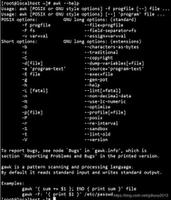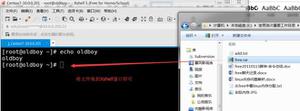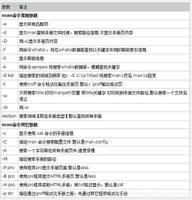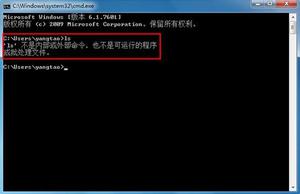Linux命令(5)tar命令

tar命令
功能说明:备份文件
用法:tar [选项]… 归档及压缩文件名 FILE...
注意:tar命令选项中可以省略“-”
选项 作用 -c
创建.tar格式的归档文件
-C
展开归档时指定目标文件夹
-f
表示使用归档文件
-t
列表查看归档内的文件
-x
解开.tar格式的包文件
-z
调用gzip程序进行压缩或解压
-j
调用bzip2程序进行压缩或解压
-J
调用xz程序进行压缩或解压
-r
添加文件到已经归档的文件
-p
打包时保留文件及目录的权限
-v
输出详细信息
--exclude
打包时排除指定的文件,支配通配符
-X
指定一个文件,将排除的内容写到文件中
文件归档就是把多个文件先打包成一个文件,归档有一个缺点就是不但不会减小体积,还会增大体积,一般来讲,归档以后要使用压缩工具对其执行压缩操作,归档和压缩通常要结合起来使用,归档不会删除原文件的。
示例1:将/etc目录备份为etc.tar文件
[root@node1 ~]# tar cf etc.tar /etc/tar: Removing leading `/" from member names
[root@node1 ~]# ll -h
total 28M
-rw-r--r-- 1 root root 28M Feb 25 17:46 etc.tar
示例2:查看etc.tar文件中的列表
[root@node1 ~]# tar tf etc.tar 示例3:将etc.tar文件释放到当前目录
[root@node1 ~]# tar xf etc.tar[root@node1 ~]# ls
etc etc.tar
示例4:将etc.tar文件释放到/tmp/newtest目录中
tar [选项]… 归档及压缩文件名 [-C 目标目录]
[root@node1 ~]# mkdir /tmp/new[root@node1 ~]# tar xf etc.tar -C /tmp/new
[root@node1 ~]# ll /tmp/new/
total 12
drwxr-xr-x 74 root root 8192 Feb 25 12:43 etc
示例5:创建5个文件将其打包,并将/etc/passwd添加到打包文件中。
[root@node1 ~]# for i in `seq 5`;do touch $i.txt;done[root@node1 ~]# ls
1.txt 2.txt 3.txt 4.txt 5.txt etc etc.tar
[root@node1 ~]# tar cf test.tar *.txt
[root@node1 ~]# tar tf test.tar
1.txt
2.txt
3.txt
4.txt
5.txt
5.txt
[root@node1 ~]# tar rf test.tar /etc/passwd
tar: Removing leading `/" from member names
[root@node1 ~]# tar tf test.tar
1.txt
2.txt
3.txt
4.txt
5.txt
etc/passwd
归档完成后通常需要压缩,结合压缩工具(gzip、bzip2、xz),就能实现压缩多个文件了。
示例6:将/var/log下的所有文件复制到/root目录,并分别使用gzip、bzip2、xz进行归档
[root@node1 ~]# cp -r /var/log/ ./[root@node1 ~]# du -sh log/
4.1M log/
[root@node1 ~]# tar zcf log.gz log/ #调用gzip进行压缩
[root@node1 ~]# tar jcf log1.bz2 log/ #调用bzip2进行压缩
[root@node1 ~]# tar Jcf log2.xz log/ #调用xz进行压缩
[root@node1 ~]# du -sh *
4.1M log
300K log1.bz2
204K log2.xz
412K log.gz
示例7:创建{a-e}5个txt文件,并将其打包,但是打包过程中排除a.txt和b.txt
[root@node1 ~]# mkdir /tmp/test[root@node1 ~]# cd /tmp/test
[root@node1 test]# for i in {a..e};do touch $i.txt;done
[root@node1 test]# ls
a.txt b.txt c.txt d.txt e.txt
[root@node1 test]# tar cf test.tar *.txt --exclude=a.txt --exclude=b.txt
[root@node1 test]# tar tf test.tar
c.txt
d.txt
e.txt
示例8:将root目录下的所有文件打包,但排除mp3文件。
[root@node1 test]# for i in `seq 10`;do touch $i.mp3;done[root@node1 test]# ls
10.mp3 1.mp3 2.mp3 3.mp3 4.mp3 5.mp3 6.mp3 7.mp3 8.mp3 9.mp3 a.txt b.txt c.txt d.txt e.txt
[root@node1 test]# tar cf text.tar *.txt --exclude=*.mp3
[root@node1 test]# tar tf text.tar
a.txt
b.txt
c.txt
d.txt
e.txt
示例9:将示例8中的mp3文件打包,但排除1.mp3、3.mp3、5.mp3
[root@node1 test]# cat >>exclude.txt<<EOF> 1.mp3
> 3.mp3
> 5.mp3
> EOF
[root@node1 test]# tar cf mp3.tar *.mp3 -X exclude.txt
[root@node1 test]# tar tf mp3.tar
10.mp3
2.mp3
4.mp3
6.mp3
7.mp3
8.mp3
9.mp3
原文链接:https://www.cnblogs.com/shijunxian/archive/2020/05/17/12907678.html
以上是 Linux命令(5)tar命令 的全部内容, 来源链接: utcz.com/z/516540.html









